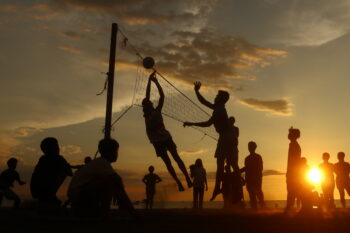COTABATO CITY (MindaNews/04 May) — Have CSOs (civil society organizations) in Mindanao reduced themselves to being cheering squads for the GPH-MILF (Government of the Philippines-Moro Islamic Liberation Front) in their peace talks?
Before answering that question, let me say that I am sharing this reflection as I am also part of Civil Society, defined by Wikipedia as “…the aggregate of non-governmental organizations and institutions that manifest interests and will of citizens. Civil Society includes the family and the private sphere, referred to as the “third sector” of society, distinct from government and business [http://en.wikipedia.org/wiki/Civil_society…]”
Thus, whatever I say here is not plucked from thin air, but based on personal experience. I may interchange CSO, NGO, international organizations, to mean one and the same in this article. There are things we are uncomfortable doing as individuals but are compelled to do collectively within the NGO culture. It may or may not be applicable to some; but then again, real and true only from my own perspective. It may strike sensitivities; but I believe that only sincere introspection would straighten this evolving reputation of CSOs, on whether we “manifest the interest and will of citizens”.
Whatever is factually incorrect in this article is solely my responsibility.
Where we are – Conflict Affected Mindanao or CAM (to separate us from the rest of the island that did not experience the types of wars we went through), NGOs have mushroomed to a thick alphabet soup after the signing of the GRP-MNLF Final Peace Agreement in 1996. That time it was still considered scandalous to spend money on car rental where the same amount could have already built a small house for one bakwit family.
Donor money required local partners to be able to implement projects. There was a mad rush to form cooperatives without necessarily cooperating. Suppliers and service providers were screened supposed to be for best value at lowest cost. Track records were retrofitted to suit donor requirements. Insiders saw the opportunity to incorporate some business entity overnight. Capacity building took the form of being able to package oneself professionally rather than the capacity to build desired, long-lasting outcomes. The uncomfortable term was “donor-driven advocacy,” where as long as one is adept at using technical terms like proposal, outputs, outcomes, commitment, challenges, strategic planning, graphically describing how conflict-ridden is a place, putting in figures whose only modicum of truth is that it was provided by local government units – funding is assured.
But by what standards should CSOs be measured up in their respective advocacies, mandates, vision, mission, goals and objectives? (The immediate thing that comes to mind is the Culture of Peace Framework of Dr Toh Swee Hin. Dr Toh introduced Peace Education to the Philippines in the 1980s; and since Notre Dame University saw the horrors of the 1970s war, it was the only taker then).
Promotion of the Culture of Peace was also a major component of the SPCPD-NEDA-UN-MDP [Southern Philippines Council for Peace and Development (SPCPD); National Economic and Development Authority (NEDA); United Nations (many UN Agencies and Donor Countries); Multi-Donor Program] (which became GRP-UN-MDP [Government of the Republic of the Philippines; United Nations; Multi-Donor Programme] and then ACTFORPEACE [Action for Conflict Transformation for Peace Programme] or A4P). A handful of peace-building frameworks was also tried by others but as to what was the most effective among these there should be good documentation somewhere.
It seems like everybody was in a hurry to let both combatants and victims go from arms to farms, bala to pala, bullets to ballots, be good business managers, politicians, effective organizers, entrepreneurs, institution-builders, birth-spacers, peace-builders – within a time frame shorter than what the war itself took.
In between, there were still wars, smaller ones. This time it was mostly between the GPH [Government of the Philippines] (from GRP it became GoP then GPH) and the MILF and its spin-off, the Bangsamoro Islamic Freedom Fighters (BIFF). While many among us have become experts in mouthing peace slogans, there was still a huge disconnect between the peace as envisioned compared with what was happening. The peace process is often used as an excuse not to implement laws against narco-politics, gun proliferation, bad governance or the lack of it, logging, mining, smuggling, etc.
As there has been no war the scale of the foiled 2008 MOA-AD (Memorandum of Agreement on Ancestral Domain), there is an uncomfortable acceptance that, yeah, maybe this is peace.
But hasn’t it also been said that peace is not just the absence of war? While Culture of Peace and Peace-building have become buzzwords for a time within the development circles, it seems it has become a very rare word these days. Maybe it has become boring.
To compare with Dr. Toh’s Peace Framework:
1. Dismantling the Culture of War;
2. Living with Compassion and Justice
3. Promoting Human Rights and Responsibility
4. Living in Harmony with the Earth
5. Building Cultural Respect, reconciliation and solidarity
6. Nurturing inner peace
Dismantling the Culture of War. Offhand, one aspect that CSOs can be commended for being successful at is promoting the mantra of NO TO WAR. Everybody hated war so much it had to stop. Everyone seems to be tired of war: rebel, soldier, victim, survivor, humanitarian worker, bystander. Even children paraded (or were made to parade?) bringing placards. Maybe the only ones who are disappointed that the war stopped are those who cashed in on donor money intended to help the victims.
Living with Compassion and Justice. There seems to be one NGO each for any sector, for any cause. NGOs for women, for children, for the youth, the elderly. (Wait: Since the family is the basic unit of society, are there NGOs focusing on families?) They are vulnerable groups and they need special protection and attention. But through the years Conflict-Affected Mindanao (CAM) has been through this cycle, were studies ever conducted on the levels of self-esteem of war-affected individuals, much less their psychological and mental health? Psychosocial interventions sound sexy, but what is it really?
In the early years of rebuilding from war, I got my first thought-provoking comment from a combatant: “You (foreign agencies) just come here with your bottled water.”
While cries for justice are common, compassion is almost not discussed: Compassion is feeling for the other, being one with the other. How can one indeed, while helping a war-ravaged community build say, a water system, brandish innocently, bottled water? How can one discuss food security to a community and splurges on the latest foodie craze upon returning to the city? Can communities really warm up to NGO workers who visit them in fancy cars and yes, fancy outdoorsy clothing and gadgets?
Promoting Human Rights and Responsibility. CAM is beset with violations, human rights and more. But surprisingly, documentation of violations of the rights of indigenous peoples (IPs) seems to be on the radar of CSOs only very recently. Forgive the bias, but I knew about IP issues in Maguindanao only at the time I got involved with them — just this couple of years. Everybody was just too busy making itself visible to the next big donor only a few souls saw the need to bring to the arena this group whose issues were always shoved under the rug because they did not have guns to catch attention.
Living in Harmony with the Earth. Consumerism is an environmental issue. Never in the history of CAM had business been brisker hereabouts. Rarely can you now find trainings conducted by CSOs that do not involve at least two snacks and one meal per day. These heavy meals have to have soft drinks or flowing coffee and all together cost more if catered than bought straight out of a store. And yes, those disposable cups and styro boxes, plastic straws, spoons and forks; plastic folders and ID cases; kits that accumulate thru months and years of rehashed seminars and workshops. Hotels, restaurants and catering services are flourishing it’s a wonder that conflict actually continues to be the motivation for aid, er, investment. Rarely can you now find workshops or trainings where participants bring their own ballpens and baon, thanks to NGO culture. Talk about self-reliance.
(Let me digress a little. There was light talk among colleagues shortly before the CAB was signed. The exchange goes something like this, “Of course, other cities will support the CAB. Don’t you notice that after the GRP-MNLF Peace Agreement was signed, that was also the time Davao, Gensan, Marbel and Cagayan de Oro boomed? Donor money did not circulate much here in Cotabato City. People from here preferred to have their seminars there so that they can go sightseeing, shopping afterwards; and if they’re male, be educated on how red-light districts operate!”)
While some CSOs advocate for environmental protection, there’s not much they can do with conflicting national and local policies towards granting mining and logging permits to big companies; a government as primary endorser of chemical inputs and seeds that can’t produce its next generation; and the welcoming of bananas and African palm to maximize cheap labor from unschooled constituents.
Building Cultural Respect, reconciliation and solidarity. A fellow worker from one NGO texted me: “Settlers should just leave it to the Maguindanaons and the Teduray, Lambangian and Dulangan Manobo to settle their conflicts within themselves.”
It came as a surprise as I never thought being a settler is actually an issue against giving assistance towards the marginalized.
So I asked: “Does your suggestion also apply to other CSOs/NGOs whose staff are settlers helping in the conflict-affected areas of Maguindanao?”
Let me just leave the long exchange at that.
I thought: what should the Maguindanaons get that the Lumads are not entitled to in this whole context of CSOs providing support to the marginalized, the vulnerable and the weak? What purpose then, would CSOs have if they do not represent the marginalized, the vulnerable and the weak? Had the Maguindanaons really helped the Lumads in their vulnerable state, would the latter have asked for help from outside? Going further, had the MNLF or the MILF resolved its conflict with the government, would it have asked help from third country facilitators? And so on and so forth.
IPDEV made an assessment of the NGOs/CSOs assisting the Lumads or non-Moro IPs in the ARMM (80 barangays in Maguindanao and Lanao del Sur). There are those who claim to be tri-people; but gravitate towards assisting mostly the Muslims and the Christians. Only one is purposely for the Lumads. Not to put fault on these NGOs, but maybe that’s just the way things are: the dominant culture always surfaces. But the discussion is evolving – a realization that there are not only three peoples in Mindanao.
Nurturing inner peace. What if CSOs teach and practice that if a person is at peace with himself, the world would be one unpeaceful person less? CSOs are no different from any other social grouping. They too have their share of office dynamics, organizational cultures and sub-cultures, intra- and inter-organizational friction, personal and relationship struggles, credit and billing concerns that tarpaulins now compete with epals, transparency and accountability issues.
Why are CSOs putting labels on each other if they don’t agree with each other’s ideas? Calling each other spoilers, evil whisperers, traitors, etc? With the internet and virtual warriors on Facebook, labeling and name-calling has multiplied exponentially over time.
It is said that in peace, the process is as important as the goal. Does unpeaceful language really have a place in a peace process? Did their Culture of Peace or lessons on Peacebuilding fly off the window if we CSOs got any at all?
This language, this war of words – belie our causes.
October 2012 and March 2014. The Framework Agreement on the Bangsamoro (FAB) and the Comprehensive Agreement on the Bangsamoro (CAB) respectively, are signed. Nobody was quite prepared, aside from the peace panels, on this major development in the peace talks.
I still maintain that no amount of consultations will promote understanding on what is going on. Consultations, roadshows, caravans have become a one way traffic of disseminating information it doesn’t look any different from an election campaign. Aren’t these just good excuses to spend money? Better than spending it on war, so they say.
On second thought, had combatants been sent back to school or given some catch-up educational program to resume what they have left off when they joined the revolution, would they have been PhDs, Doctors, Engineers, Scientists, Managers etc many times over by now, after 17 years? Had the money spent on checklists of trainings (menu-type choices) been spent instead on elementary schools (okay, basic education – Reading, wRiting, aRithmetic), shouldn’t it have been less difficult now to explain concepts like power sharing, wealth sharing, transitional mechanism, demobilization, self-determination, self-reliance, dignity of honest labor, industriousness – that whole spectrum of values because they know how to read and write in English, Filipino and their mother tongue?
Some CSOs are aggressively campaigning for people to say YES to the Bangsamoro Basic Law. No problem. But do they really expect results without people really understanding the issue in the first place? Saying yes without understanding just to please both panels? That’s not very democratic – that’s coercion. This way CSOs lose their independence towards being the arbiter, the neutral ground, ensuring that both sides are true to their word.
And oh, by the way, people in the CAM are not only composed of the GPH and MILF. By being cheering squads only to the two panels, we CSOs have failed to “manifest the interest and will of citizens” and lost the opportunities to bring the other affected peoples to the peace side of the fence.
Sayang.
[MindaViews is the opinion section of MindaNews.Aveen Acuña-Gulo has worked with the United Nations under different programs since 1998 (IOM, UN-MDP, UN Volunteers, UN-World Food Programme). She is currently the Project Manager of IPDEV, a three-year EU-assisted project for the recognition and empowerment of indigenous peoples in the ARMM. IPDEV is implemented by the consortium of Konrad Adenauer Stiftung, Institute for Autonomy and Governance and Development Consultants. The views expressed here are the author’s and do not necessarily reflect the views of the EU, KAS, IAG and DEVCON.
She wrote a column “The Voice” for the Mindanao Cross from 1991-2006. She likes to challenge stereotypes.“Don’t worry about my opinions,” she says. “It won’t make a dent to the conventional.” ]







